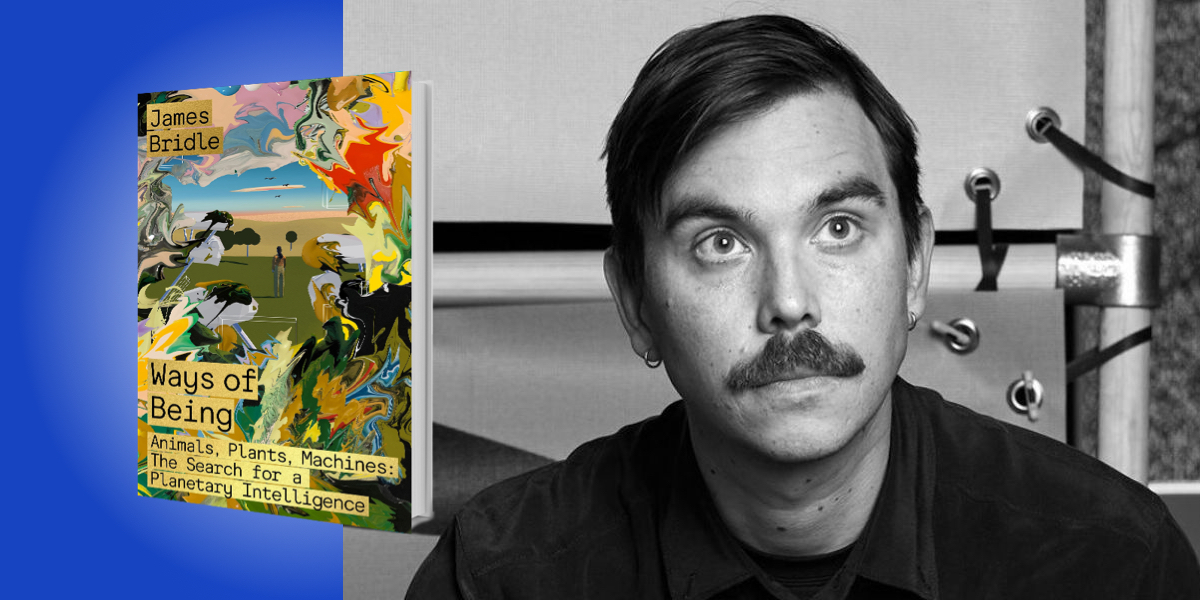James Bridle is a writer, artist, and technologist whose writing has been featured in numerous publications, including Wired, The Atlantic, and the Financial Times.
Below, James shares 5 key insights from their new book, Ways of Being: Animals, Plants, Machines: The Search for a Planetary Intelligence. Listen to the audio version—read by James personally—in the Next Big Idea App.

1. Everything is intelligent.
Humans are bad at recognizing intelligence because we tend to define intelligence as “what humans do.” But when we think about the world from the perspective of other beings, their abilities become clear. Consider the gibbon. Gibbons belong to the same class of large-brained mammals as chimpanzees, bonobos, and us, so we should expect them to be able to solve the same kinds of puzzles. But for years, gibbons have failed classic tests of intelligence: picking up cups to look for treats underneath, or using sticks and poles to reach food placed outside their cages.
In the eyes of science, they appeared dumb. It was only when scientists redesigned their experiments—for example, by hanging the sticks from the ceiling of the gibbons’ enclosure—that the gibbons sprang into life and grabbed their treats, becoming scientifically intelligent. Of course, they’d been smart all along, but gibbons are arboreal (they live in the treetops) and expect their tools to be found above their heads. They have an arboreal intelligence: a way of thinking in the world that matches their bodies and environment.
The more we think about how other beings live their lives, the more we find out how they do intelligence. This can take many forms: spiders store memories and plans in their webs, prairie dogs call out the species and appearance of different predators, and bees dance the location of new nesting sites before voting on them. Everything is intelligent.
“The more we think about how other beings live their lives, the more we find out how they do intelligence.”
2. Plants can hear and remember.
A few years ago, researchers recorded the sound of cabbage white caterpillars munching on the leaves of a cress plant. When they played the sound back to other cress plants, they found that the plants responded in exactly the same way that they did to the presence of actual caterpillars: they immediately flooded their leaves with chemical defenses to deter the predators. Crucially, they didn’t do this when they heard the sound of wind, or different insects. They heard and recognized a particular sound, and acted on it—and we don’t know how they do it.
Other experiments have shown that plants can learn from experience: mimosa plants, dropped a short distance, learn to ignore the shock, and react differently to future events. We’ve long thought of plants as insensitive and immobile, but they actively pay attention, process and store information, and behave based on their experiences. They’re doing all of the things that in animals we call “intelligent.”
We can never know what it is like to be a plant, but we can understand that we share the world with them: hearing the same sounds, feeling the same sun, and breathing the same air. We share a world, so we can think about building better worlds together.
3. Everything is really everyone.
In the early 20th century, biologist Jakob von Uexkull coined the term “umwelt” to describe the perspective of a particular organism. The umwelt of a tick parasite, for example, consists of three specialized factors: the odor of butyric acid, which indicates the presence of an animal to feed upon; the temperature of 37 degrees Celsius, which indicates the presence of warm blood; and the hairiness of mammals, which it navigates to find sustenance. From these three qualities, the tick’s whole universe blooms.
“We are walking assemblages of many beings: the 2.5 kilos of other organisms that we carry around (mostly in our gut) affect our health, moods, and intelligence.”
Every organism has an umwelt, its individual sense that connects it to the world—fish, fruit flies, bacteria, fungi, and even some machines. Every umwelt is a world in miniature, and these multiple worlds overlap to create the world we share.
In fact, it’s increasingly difficult to talk about individuals. We are walking assemblages of many beings: the 2.5 kilos of other organisms that we carry around (mostly in our gut) affect our health, moods, and intelligence. Throughout history, we’ve constantly exchanged genetic information with other beings: 50 percent of the human genome consists of DNA sequences written into it by other organisms at various times in our evolution. We are who we are because of everybody else.
4. People can talk to animals, and think with them too.
The Yao people of Mozambique have been gathering honey in the forests and savannah of the Niassa region for thousands of years. The honeycombs are often hidden at the tops of trees, so they ask for help finding them. A Yao honey-hunter will go into the forest and make a particular call which is answered by a honeyguide—a small, brown bird who also loves honey, but whose beak is too small to break open the tough outer casing of wild honeycombs.
Swooping and trilling through the treetops, the honeyguide shows the hunter to a hive, and in return, the hunter leaves the waxy comb and bee larvae for the honeyguide to feast on. Studies have shown that the call made by the honey-hunters is distinct. It is a word recognized by the honeyguides as separate from other sounds.
“Our intelligence is a product of our relationships—with other people and species.”
It’s possible that this association was critical to human evolution: better nutrition and increased social interaction with the world around us is what gave humans large and complex brains. Our intelligence is a product of our relationships—with other people and species. It is in concert with the beings that surround us, and with whom we are in constant communication.
5. Many creatures are smarter than us.
Slime molds are strange, unicellular creatures (a little like amoebae, a little like fungi) that grow on old logs and forest floors. But they have one particular ability: they are very good at route planning. A few years ago, researchers used slime mold to recreate the Greater Tokyo transit system. They made a map with oat flakes (a slime mold delicacy) representing city centers, and light and shadow marking rivers and mountains. Within 24 hours, the slime mold, polycephalum physarum, had found the most efficient route between cities and around obstacles—a task that took decades for the best human engineers.
They can also solve harder conundrums, such as finding the shortest route between a number of cities while visiting each one only once. This is the kind of problem that people and computers find difficult because there are a huge number of possible solutions, and the problem gets harder every time you add a city. But slime molds solve the problem faster and more efficiently than either people or the most advanced supercomputers.
This problem is just not that hard for slime molds. It’s simply what they do, because they do intelligence differently from us. Imagine what other things we could learn from animals, plants, and whole ecosystems if we could imagine the intelligence they possess differently, and learn to ask them better questions.
To listen to the audio version read by author James Bridle, download the Next Big Idea App today:































